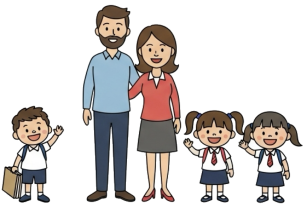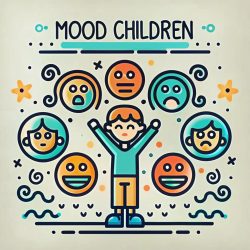
Question More, Action Knowledge.
Remember, at QMAK, we don’t just teach; we empower. We don’t just inform; we inspire. We don’t just question; we act. Become a Gold Member, and let’s unlock your child’s full potential, one question at a time.
Back to Mind Explorers
![]()
This game helps children develop emotional intelligence and self-awareness by teaching them to approach their moods, especially bad moods, with curiosity, acceptance, and compassion. By investigating the physical sensations and thoughts associated with a bad mood, children learn to recognize and understand their emotions without being overwhelmed by them.
Playing with the bad mood and experimenting with changing its characteristics can help children feel more in control of their emotional experiences and less controlled by them. This can foster a sense of resilience and adaptability in the face of challenging emotions.
Exploring the thoughts and stories that feed the bad mood can help children understand the role of their own mind in creating and maintaining emotional states. This awareness can empower them to choose different thoughts or stories that support their well-being.
Finally, by imagining the bad mood as a protective guard or a child they love, children can develop a more compassionate and accepting relationship with their emotions. This can lead to greater emotional balance, self-acceptance, and overall well-being.
Hey there, young emotion explorer!
Today, we're going to play a fun game called "The Mood Explorer."
This game will help us understand and work with our moods, especially when we're feeling down or upset.
We'll be using our imagination and curiosity to investigate our bad moods, play with them, and even learn from them.
It might seem a bit strange at first to focus on a bad mood instead of trying to make it go away, but trust me, it can be really helpful and interesting!
Are you ready to become a mood explorer?
1. When the child is experiencing a bad mood, encourage them to take a moment to investigate it instead of immediately trying to make it go away. Help them get curious about how they know they’re in a bad mood and what the evidence is in their body and mind.

2. Guide the child to play with the bad mood by asking them to experiment with making it bigger, smaller, louder, quieter, darker, lighter, or moving it to different parts of their body. Encourage them to approach this step with a sense of playfulness and curiosity.

3. Have the child investigate the thoughts and stories that feed the bad mood. Ask them to consider what would happen if they couldn’t get rid of the bad mood or if they actually wanted it to stay.
4. Encourage the child to inquire about who or what is noticing the bad mood. Help them experience the bad mood without getting caught up in the thoughts and words associated with it.

5. Ask the child to imagine that the bad mood is there to protect them, like a loyal guard. Encourage them to thank the “guard” for its service and then check in with who or what is aware of the guard.

6. If the above steps are too complex, introduce the simple “Mood Children” game. Have the child imagine that all their moods are children that they love equally and encourage them to welcome the bad mood with open, loving arms.

To further explore the concept of befriending and learning from difficult emotions, consider introducing your child to the book “In My Heart: A Book of Feelings” by Jo Witek.
This beautifully illustrated book takes children on a journey through a wide range of emotions, from happiness and sadness to fear and courage.
1. What shape is used throughout the book to represent different feelings?
a) Stars
b) Circles
c) Hearts
d) Squares
2. How does the book describe happiness?
a) As a heavy feeling
b) As a bright yellow feeling
c) As a dark blue feeling
d) As a feeling that makes you want to sleep
3. What color is associated with anger in the book?
a) Red
b) Blue
c) Green
d) Purple
4. How does the book describe the feeling of sadness?
a) As something that makes you want to hide
b) As something that makes you want to dance
c) As something that makes you feel powerful
d) As something that makes you feel hungry
5. What does the book say about fear?
a) It’s always a bad feeling
b) It can make your heart feel small
c) It’s the same as excitement
d) It only happens at night
6. How is calmness depicted in the book?
a) As a stormy ocean
b) As a loud drum
c) As a quiet pond
d) As a racing car
7. What does the book say about how feelings can change?
a) Feelings never change
b) You can only have one feeling at a time
c) Feelings can change quickly, like the weather
d) Only adults have changing feelings
8. How does the book describe the feeling of shyness?
a) As wanting to be the center of attention
b) As wanting to hide or be invisible
c) As feeling very brave
d) As feeling very angry
9. What does the book say about having different feelings?
a) It’s bad to have too many feelings
b) All feelings are important and okay to have
c) We should only have happy feelings
d) Feelings are not important
10. What is the main message of the book?
a) Feelings are confusing and should be ignored
b) Only happy feelings are good
c) All our different feelings make us who we are
d) Feelings are only for children
1. c) Hearts
2. b) As a bright yellow feeling
3. a) Red
4. a) As something that makes you want to hide
5. b) It can make your heart feel small
6. c) As a quiet pond
7. c) Feelings can change quickly, like the weather
8. b) As wanting to hide or be invisible
9. b) All feelings are important and okay to have
10. c) All our different feelings make us who we are
Verse 1:
When a grumpy cloud comes to stay
Don’t push it out, don’t run away
Take a look with curious eyes
You might just find a big surprise
Pre-Chorus:
Investigate, don’t hesitate
Your mood’s got stories to relate
Chorus:
Hello, little mood, what brings you here?
Let’s play a game and draw you near
Bigger, smaller, dark or light
You’re welcome here, it’s gonna be alright
Verse 2:
Imagine it’s a guard so brave
Protecting you from what you crave
Or picture it’s a child so dear
Needing love when skies aren’t clear
(Pre-Chorus)
(Chorus)
Bridge:
Who’s watching all this come and go?
The real you, don’t you know
Moods are visitors, they don’t define
The wonder that is truly mine
(Chorus)
Outro:
So next time when you’re feeling blue
Remember what explorers do
Welcome moods with open arms
And find the gifts in all their charms

Remember, at QMAK, we don’t just teach; we empower. We don’t just inform; we inspire. We don’t just question; we act. Become a Gold Member, and let’s unlock your child’s full potential, one question at a time.